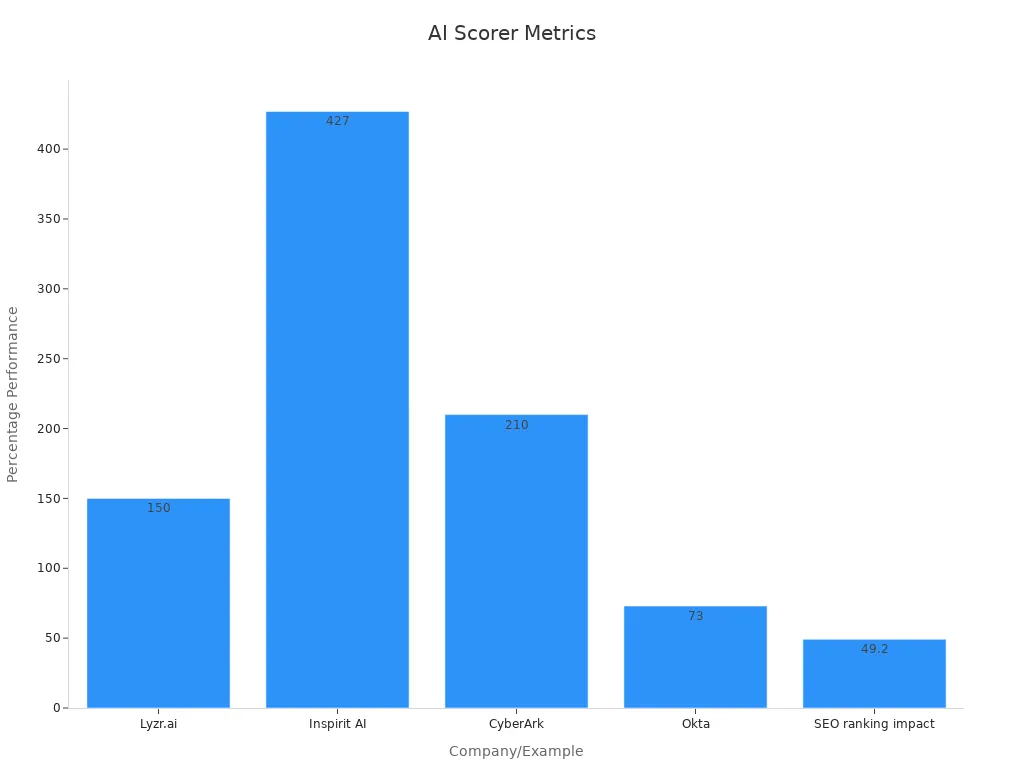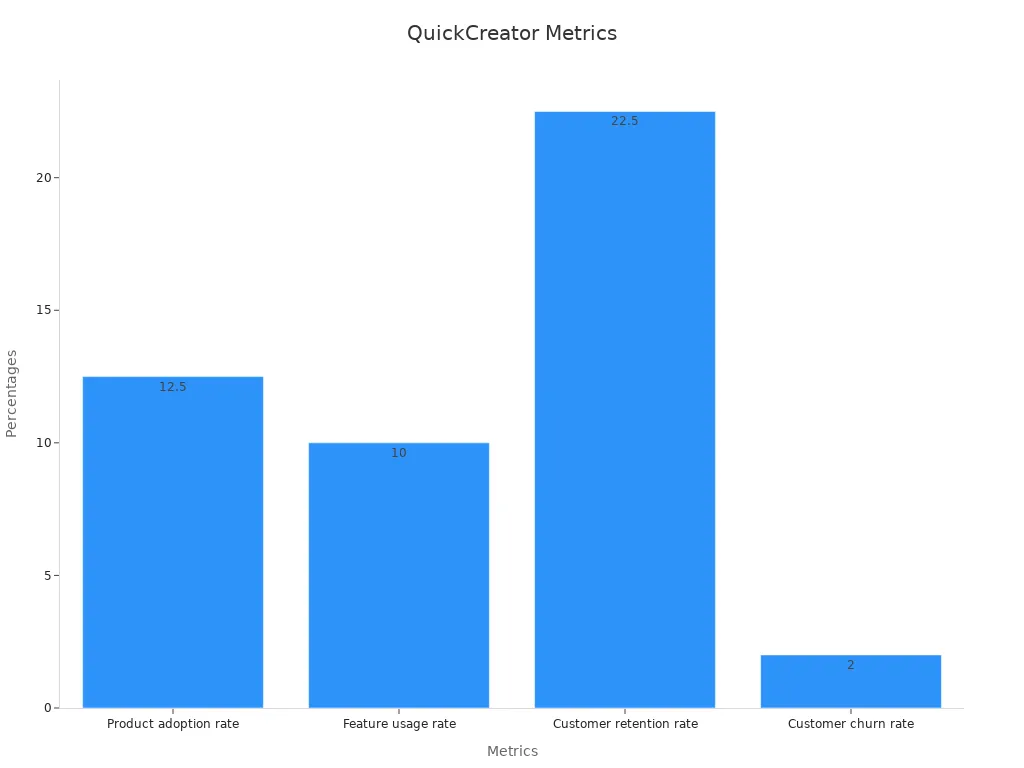QuickCreator for Multi-Metric Content Assessment

QuickCreator uses smart AI to look at content in many ways. This helps marketing teams get better ROI and build trust. Businesses get real results with QuickCreator. For example, tech companies using AI-driven content get 50 percent more organic traffic. In ecommerce, personalized content makes click-through rates go up by 30 percent. Travel sites using AI for content optimization rank in the top three for 70 percent of their target phrases. QuickCreator works well with Shopify and WordPress. This makes it easy for any business to improve content marketing for ecommerce. Marketers trust QuickCreator for fast, correct, and useful content insights that help marketing ROI.
Key Takeaways
QuickCreator uses AI to check content with many metrics. This helps teams get better marketing results and build trust.
Multi-metric assessment checks accuracy, completeness, engagement, SEO, conversions, and authoritativeness. This gives a full view of the content.
Using many metrics helps find problems and reduce bias. It also helps teams make better content choices that increase traffic and sales.
QuickCreator works well with Shopify and WordPress. It is easy to set up and has a simple dashboard for quick insights.
Tracking and improving key metrics with QuickCreator brings more engagement, better SEO, and a stronger ROI.
Multi-Metric Assessment

What It Means
Multi-metric assessment means checking content with many metrics, not just one. This way, teams see how well content works in marketing. They look at accuracy, completeness, consistency, timeliness, validity, and uniqueness. Each metric shows a different part of content quality and seo content performance.
Note: Using many content marketing metrics helps teams catch important things. Accuracy checks if facts are right. Completeness makes sure all needed info is there.
A multi-metric approach uses set rules and benchmarking. Institutions can compare their results with others to find ways to get better. This method helps track content marketing success by showing how content compares to others. It also helps teams make their content marketing strategies better over time.
Metric Type | What It Measures | Why It Matters |
|---|---|---|
Accuracy | Real-world representation | Trust and reliability |
Completeness | All data points present | No gaps in content |
Consistency | Uniformity across data | Reliable content analysis |
Timeliness | Data availability | Fast decision-making |
Validity | Realistic depiction | Builds trust |
Uniqueness | No duplication | Single source of truth |
Why It Matters
Multi-metric assessment is important for marketing. It shows the full effect of content. Using only one metric can hide problems or make things look better than they are. Different content marketing metrics, like seo, engagement, conversions, and authoritativeness, give special insights about content.
Big marketing goals need more than one metric. Many measures help break big goals into smaller, clear steps.
Using several metrics lowers bias. It keeps teams from missing important areas.
Multi-metric content analysis stops teams from only improving one metric.
Combining metrics helps with prediction and checking, especially when one metric is not clear.
Using separate metrics keeps results honest and makes content analysis better.
Studies show that multi-metric assessment makes models stronger and improves seo content performance. It helps teams make content better for organic traffic, engagement, and conversions. This way, content marketing metrics become more useful because content analysis is more exact and quick. Teams can see how their content does, change plans, and track content marketing success.
Multi-metric assessment also helps when sensitivity and specificity matter. This is important for seeing the real effect of content on organic traffic. By using many content marketing metrics, marketing teams can see the true value of their content and make better choices for future campaigns.
QuickCreator Features
AI Content Quality Scorer
QuickCreator has a smart AI Content Quality Scorer. It looks at content in many ways. The tool checks structure, engagement, and seo optimization. Teams use it to make content better and get more roi. The scorer checks keyword rankings and dwell time. It also looks at how easy the content is to read. It tracks traffic, conversions, and engagement. This includes time on page and bounce rates.
Many companies have seen big gains with QuickCreator. Lyzr.ai got 150% more organic traffic by finding keyword gaps. Inspirit AI grew organic traffic by 427% in three months. They did this by using long-tail keywords. CyberArk saw a 210% jump in organic traffic with special guides. These results show QuickCreator helps seo and roi.
Company/Example | Metric/Outcome | Description/Context |
|---|---|---|
Lyzr.ai | 150% increase in organic traffic | Used AI content scoring to identify keyword gaps and optimize content, resulting in traffic growth. |
Inspirit AI | 427% boost in organic traffic over 3 months | Focused on long-tail keywords and "People Also Ask" queries to drive traffic. |
CyberArk | 210% rise in organic traffic | Created practitioner-led guides with AI-driven content strategy. |
Okta | Featured snippets for 73% of target keywords | Focused on authoritative identity security documentation. |
CrowdStrike | Ranking for 1,200+ keywords; 35% of organic leads | Combined topic clustering with AI scoring to enhance keyword rankings and lead generation. |

QuickCreator’s automation makes seo optimization and keyword use easy. The platform saves time by making good blog posts and landing pages. Brands can change content to fit their style and audience. Users say an e-commerce store got 50% more organic traffic in three months. The simple interface and helpful support make content analysis easy for teams.
EEAT and Trust
QuickCreator helps teams check content using EEAT. EEAT stands for Experience, Expertise, Authoritativeness, and Trustworthiness. Google uses EEAT to judge content. New updates reward sites with strong EEAT. QuickCreator helps teams build trust. It checks for correct facts, clear author names, and new content.
Note: Trustworthiness is the most important part of EEAT. QuickCreator makes sure content is accurate and open.
A timeline shows how EEAT and trust have become more important:
Date | Update Name | Description & Relevance to E-E-A-T and Trust Metrics |
|---|---|---|
August 1, 2018 | Medic Core Update | Focused on improving assessment of Expertise, Authoritativeness, and Trustworthiness, especially for health content. |
December 2022 | Addition of 'Experience' | Expanded the framework to E-E-A-T, emphasizing firsthand experience in content creation. |
February 2023 | Product Reviews Update | Rewarded reviews showing genuine experience and expertise. |
August 2023 | Core Update | Reinforced the importance of E-E-A-T in content evaluation. |
September 2023 | Helpful Content Update | Promoted people-first, genuinely helpful content aligned with E-E-A-T standards. |
QuickCreator’s tools help teams watch these metrics. By making EEAT better, businesses get better seo and more engagement. ROI goes up. Content quality gets better, and users trust what they read.
Content Marketing Metrics

QuickCreator checks many important content marketing metrics. These metrics help teams see how their content works. Using more than one metric gives a bigger picture. Teams can look at content from different sides. This helps them make better choices and grow their business.
SEO Metrics
SEO metrics show how content does in search engines. These include impressions, search visibility, rankings, organic traffic, and click-through rates. Impressions tell how often content shows up in searches. More impressions mean more people see it. Rankings show where content is in search results. Higher rankings bring more visitors and leads.
Click-through rate (CTR) tells how many people click after seeing content. A high CTR means the content fits what users want. Organic traffic counts people who find content through search. Watching these numbers helps teams know what topics bring visitors. Data from over 8,000 companies shows top ones get almost 20,000 sessions each month. The middle number for impressions is about 63,000. Top companies get over four times more clicks than most. Most teams use on-page SEO, keyword research, and update content to do better. Making content match what people search for helps rankings and traffic the most. These numbers help teams make content better and track success.
Tip: Use tools like Google Search Console and Ahrefs to watch SEO metrics and make content better.
Engagement
Engagement metrics show how people use content. These include time on page, bounce rate, pages per session, and social shares. High engagement means people like the content and stay longer. Watching engagement helps teams know what topics and styles work best.
Teams can compare engagement to others in their field to find ways to get better.
Looking at trends and groups shows how users act.
Regular reports help teams see changes over time.
Engagement numbers help teams make choices and get better ROI.
Focusing on real engagement, not just big numbers, brings better results.
Advanced numbers like user lifetime value and cohort analysis give deeper ideas for planning.
Customer engagement shows how strong the brand and audience bond is. Using this data helps teams guess future sales and improve plans. For example, Delta Air Lines used engagement data to check how well brand ads worked. Important numbers are branded search volume, time to conversion, and number of touchpoints. These ideas help leaders target better and make customers happier, which helps the business grow.
Conversions
Conversion metrics show how well content turns visitors into leads or buyers. These include conversion rate, lead generation, sales, and revenue. Conversion rate tells what percent of visitors do what you want, like signing up or buying. High conversion rates mean the content works well.
87% of people have bought something after seeing branded content or videos.
72% of top marketers use conversion numbers to check ROI.
Very personal content can boost engagement by 202%, and 80% of marketers see more conversions from this.
High engagement brings 75% better leads.
Making conversion rates better helps ROI and marketing wins.
Conversion numbers show the full effect of content. They tell how content helps get leads and sales. Watching these numbers helps teams know what content brings the most sales and money. This helps track success and plan new content.
Authoritativeness
Authoritativeness shows if content is trusted and respected. This is part of Google's EEAT rules. Good content is correct, well-researched, and known by experts. Backlinks from trusted sites help with authoritativeness. Google's rules say this is very important.
Authoritativeness means being known and respected in a field. It is measured by mentions, citations, expert reviews, and working with others. For example, WebMD is very trusted because it has links from over 616,000 sites, like apple.com and bbc.com. Tools like Semrush's Authority Score help check this. Being seen as an authority builds trust and helps a business grow. A tech startup got 36% more organic traffic and 21% more good backlinks by working with experts and doing new research. This shows how authoritativeness helps content and SEO.
Note: Authoritativeness, as shown by EEAT, is key for trust and making content work better.
How These Metrics Work Together
Each metric gives a special look at how content does. SEO metrics show how many people see it. Engagement metrics show if people like and use it. Conversion metrics tell if content brings sales. Authoritativeness builds trust and helps growth. By watching all these metrics, teams see the whole story. This helps with checking, improving, and knowing what the audience likes. It also helps with getting leads, sales, and tracking success. Using many metrics makes sure content plans help business goals and help the business grow.
Using QuickCreator
Setup and Integration
Setting up QuickCreator for ecommerce is easy. Teams can follow a few steps to get started and help seo and roi.
Pick what content to automate, like blog posts or newsletters. This helps make the automation fit ecommerce needs.
Make a content calendar. Plan topics, set dates, and pick where to share. This keeps content coming out on time.
Connect QuickCreator with WordPress or Shopify using plugins or APIs. This links your store to the platform for easy content making and posting.
Test everything. Look for mistakes or slow spots before using full automation.
Watch how things go. Use analytics to check open rates, conversions, and other numbers. Change your plan to make content work better and get more roi.
QuickCreator has a drag-and-drop interface that is simple for beginners. Users can sort content, change dashboards, and set permissions without knowing how to code. The platform lets you add articles, videos, and files by dragging and tagging them.
Dashboard Overview
QuickCreator’s dashboard shows ecommerce teams all their important numbers. The dashboard tracks sessions, users, pageviews, bounce rate, session time, conversion rates, customer cost, and roi. Teams can see data from CRM, social media, and sales in one spot. Real-time reports and cool graphs help teams see trends fast.
Users can change dashboards to show the numbers they care about.
Automation sends alerts for new data and finds problems.
Teams can share dashboards to work together and decide faster.
Updates keep data right and useful for better results.
People say engagement went up by 75% and budget mistakes dropped by 15% after using QuickCreator dashboards. The simple design and filters help teams find what they need for ecommerce growth and leads.
Metric Comparison
QuickCreator’s metric comparison tool helps ecommerce teams see how they are doing. The platform compares things like conversion rates, product use, and customer retention. Teams can see which content brings the most roi and leads.
Metric | What It Measures | Example Calculation or Result |
|---|---|---|
Trial-to-paid conversion rate | Percentage of users converting to paid plans | N/A |
Product adoption rate | Percentage of new users actively using the product | 12.5% (500 active users / 4,000 signups) |
Feature usage rate | Percentage of users using a specific feature | 10% (2,000 MAUs / 20,000 logins) |
Customer retention rate | Percentage of customers staying over time | 22.5% (450 paying customers / 2,000 customers) |
Customer churn rate | Percentage of customers leaving | 2% ((10,000 - 9,800) / 10,000) |
Case Study | Result | Key Strategy |
|---|---|---|
Loomly | 827% higher click-through rate | Updating old content regularly |

QuickCreator updates these comparisons right away, so teams always have fresh data. Teams can use tools to share ideas and make choices together. AI gives tips to help with content and seo. By watching customer happiness and checking on rivals, teams can get more roi and do better in ecommerce.
Interpreting Results
Insights for Marketing
QuickCreator helps marketing teams see how content is doing. Teams check things like keyword ranking, organic traffic, backlink quality, and time on page. These numbers show how content affects the business. Marketers use these metrics to learn about content visibility, user engagement, and how well content turns visitors into customers. HubSpot uses blogs, newsletters, videos, and social media together. This mix helps them get more engagement and sales. SaaS companies use QuickCreator to make better plans and improve user experience. They also use it to get more leads. Teams use product demo videos, webinars, and customer testimonials too. These tools help show why tracking content marketing roi matters for business growth.
Tip: Marketers should look at funnel performance, social media reach, and email open rates. These metrics help measure how content supports business goals.
Optimizing Content
Teams use QuickCreator insights to make content better. They check search volume, click-through rate, bounce rate, time on page, and conversion rate. The table below explains how each metric helps with making content better:
Metric | Description |
|---|---|
Search Volume | Shows how many people want a topic |
Click-Through Rate | Tells how many users click on content |
Bounce Rate | Shows if users leave fast or stay |
Time on Page | Tells if people are interested in the content |
Conversion Rate | Shows if content gets users to take action |
One company got 9,500 more weekly visits by using automated internal linking. Another company got 35% more newsletter sign-ups after testing CTA buttons. E-commerce brands sold more by making content about their products. Personalized user paths made engagement go up by 40%. QuickCreator’s analytics help teams find trends, fix content gaps, and keep content new. Checking and changing content often helps teams get the most out of content marketing roi.
Improving ROI
QuickCreator helps businesses see how content affects roi. The Organic Growth Engine program helped over 40 companies double their conversion rates and make more money. Tomaque worked with a power bank brand and got more organic traffic, better search visibility, and more sales. Data shows 49% of marketers think organic search gives the best roi. Also, 51% of website traffic comes from organic search. These facts show why tracking content marketing roi is important. Teams can see how content helps business growth and make smarter choices. QuickCreator’s tools help teams get the most out of content marketing roi by showing what works and what needs to change.
Strategy and ROI
Aligning Metrics with Goals
Ecommerce teams do better when their content metrics match business goals. They use marketing analytics to see how content helps sales and customer loyalty. These teams also track brand growth. Big companies like HubSpot, Salesforce, and Amazon use financial roi metrics. Some examples are Customer Lifetime Value and Marketing Return on Investment. These numbers help teams spend money wisely and make more revenue. Advanced analytics, like machine learning and multi-touch attribution, connect marketing work to money results. Teams also look at non-financial metrics. These include employee engagement and customer experience. These things help the business succeed too.
Teams need clear ways to measure and should use data tools. This helps fix problems with data quality and matching metrics to goals.
A good strategy means checking key performance indicators often. The table below shows how different metrics fit business goals in ecommerce:
Metric Type | Description | Business Alignment |
|---|---|---|
Reach | Unique users who see the content | Measures audience and distribution |
Organic Traffic | Visitors from unpaid search | Shows SEO success and relevance |
Search Rankings | Content position in search results | Reflects visibility and performance |
Social Shares | Content shared on social platforms | Increases reach and engagement |
Conversion and Sales | Leads, sales, and roi from content | Direct link to business revenue |
Marketing funnel optimization and CRM systems help teams track conversions at every step. This makes sure measuring content marketing roi is right and useful.
Continuous Improvement
Continuous improvement helps ecommerce marketing stay strong. Teams pick key performance indicators that match their goals. They use methods like Plan-Do-Check-Act and Six Sigma to keep getting better. Teams try new things and use feedback to change fast.
Pick KPIs that help with regular checks.
Use process maps and data tools to find good ideas.
Ask customers for feedback to see what needs fixing.
Track both numbers and feelings, like website visits and customer happiness.
Change plans when new data comes in.
AI and machine learning help teams by giving smart ideas and making choices faster. For example, a retail company got more sales by testing email subject lines. They changed their plan and saw more people open and click emails. This shows that testing and learning helps get better content marketing roi.
Leaders and workers who support each other help teams keep improving. Teams that celebrate wins and try new things do better in ecommerce.
Ecommerce content marketing works best when teams measure, improve, and match every step to business goals. This way, getting the most out of content marketing roi stays important.
QuickCreator helps ecommerce teams make smart choices by watching how content does with many marketing metrics. Marketers get better ROI, more people interact, and the brand gets stronger. For example, one big ecommerce site saw engagement go up by 30% and conversion rates rise by 20% after using QuickCreator. The dashboard shows cost, pipeline, and composite scores together for easy-to-understand ROI.
Metric Category | Example Metrics | Use Case / Insight |
|---|---|---|
Cost Metrics | Production, distribution costs | Shows how much is spent on content marketing |
ROI Metrics | Revenue, profitability ratio | Checks how content helps ecommerce sales |
Composite Scores | Unified performance indicators | Gives one simple view of content marketing success |
Marketers can try QuickCreator for free to see how it makes content creation easier and helps ROI. Keeping up with these tools helps ecommerce keep growing and do well in marketing.
FAQ
How does QuickCreator measure content quality?
QuickCreator uses AI to check content in different ways. It looks at SEO, engagement, conversions, and trust. The platform checks if facts are right and if the content is complete. It also checks if experts trust the content. Teams get easy-to-understand scores and tips to make things better.
Can QuickCreator integrate with Shopify and WordPress?
Yes, QuickCreator works with Shopify and WordPress. Teams can use plugins or APIs to set it up fast. This helps teams make and post content without much work.
What metrics does QuickCreator track?
QuickCreator checks SEO, engagement, conversions, and authoritativeness.
Teams see numbers like keyword rankings, bounce rates, conversion rates, and trust signals.
Who benefits most from using QuickCreator?
Ecommerce businesses, marketing teams, and content creators get the most help. They can get better ROI, more engagement, and more trust from their audience.
Is QuickCreator easy to use for beginners?
Feature | Ease of Use |
|---|---|
Setup | Simple |
Dashboard | User-friendly |
Support | Responsive |
QuickCreator has a drag-and-drop interface and good support. Beginners can start fast and handle content easily.
See Also
Comparing Writesonic AI And QuickCreator For Content Creation
Step-By-Step Guide To Quick Creator’s New Content Features
Easy Keyword Matrix Creation Guide For Beginners In SEO

